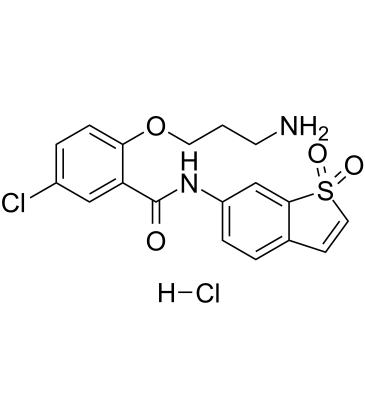HJC0416 hydrochloride
Modify Date: 2025-08-25 15:41:36

HJC0416 hydrochloride structure
|
Common Name | HJC0416 hydrochloride | ||
|---|---|---|---|---|
| CAS Number | 2415263-08-8 | Molecular Weight | 429.32 | |
| Density | N/A | Boiling Point | N/A | |
| Molecular Formula | C18H18Cl2N2O4S | Melting Point | N/A | |
| MSDS | N/A | Flash Point | N/A | |
Use of HJC0416 hydrochlorideHJC0416 hydrochloride is a potent and orally active STAT3 inhibitor with an enhanced anticancer profile than Stattic (HY-13818). HJC0416 hydrochloride is a promising anti-cancer agent for breast cancer study[1]. |
| Name | HJC0416 hydrochloride |
|---|
| Description | HJC0416 hydrochloride is a potent and orally active STAT3 inhibitor with an enhanced anticancer profile than Stattic (HY-13818). HJC0416 hydrochloride is a promising anti-cancer agent for breast cancer study[1]. |
|---|---|
| Related Catalog | |
| Target |
STAT3 |
| In Vitro | HJC0416 hydrochloride inhibits the proliferation of both ER-positive, and ER-negative (triple negative) breast cancer cells with IC50 values of 1.76 µM and 1.97 µM, respectively. However, it displays a marked antiproliferative effect against pancreatic cancer cell line AsPC1 and Panc-1 with IC50 values of 40 nM and 1.88 µM, respectively[1]. HJC0416 hydrochloride (1-10 µM; 48 hours) inhibits cell growth and induced apoptosis accompanying cellular morphological changes in MDA-MB-231 breast cancer cells[1]. HJC0416 hydrochloride (5 µM; 24 hours) decreases the STAT3 promoter activity by approximately 51%, while stattic (HY-13818) only decreases the STAT3 promoter activity by 39% in MDA-MB-231 cells after transient transfecting with pSTAT3-Luc vector[1]. HJC0416 hydrochloride (1-10 µM; 12 hours) has a comparable potency in downregulating STAT3 protein production and phosphorylation at Tyr-705 site when compares with Stattic (HY-13818). Additionally, it also induces cleaved caspase-3 and downregulated cyclin D1 levels in MDA-MB-231 cells[1]. Cell Cycle Analysis[1] Cell Line: MDA-MB-231 breast cancer cells Concentration: 1-10 µM Incubation Time: 48 hours Result: Induced cell apoptosis in cancer cells. Apoptosis Analysis[1] Cell Line: MDA-MB-231 breast cancer cells Concentration: 1 µM; 5 µM; 10 µM Incubation Time: 12 hours Result: Decreased p-STAT3 phosphorylation expression and cyclin D1 level. |
| In Vivo | HJC0416 hydrochloride (intraperitoneal injection; 10 mg/kg; 7 days) shows a 67% decrease of tumor volume as compared to the control mice. Similarly, HJC0416 hydrochloride (oral administration; 100 mg/kg; 14 days) also significantly reduces tumor volume at a dose of 100 mg/kg by 46%. The i.p. route appeared to have a better reduction of tumor volume. It is also noteworthy that HJC0416 does not show significant signs of toxicity at a dose of 100 mg/kg[1]. Animal Model: Mice with MDA-MB-231 cells[1] Dosage: 10 mg/kg (i.p.); 100 mg/kg (oral) Administration: Intraperitoneal injection, 7 days; oral administration, 14 days Result: Exhibited antitumor effects in the MDA-MB-231 triple-negative breast cancer murine xenograft model. |
| References |
| Molecular Formula | C18H18Cl2N2O4S |
|---|---|
| Molecular Weight | 429.32 |
| InChIKey | YWFDTXJORDWLGD-UHFFFAOYSA-N |
| SMILES | Cl.NCCCOc1ccc(Cl)cc1C(=O)Nc1ccc2c(c1)S(=O)(=O)C=C2 |